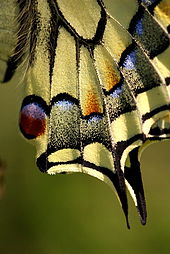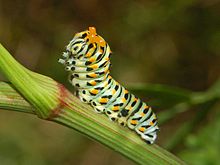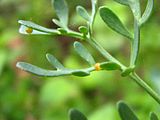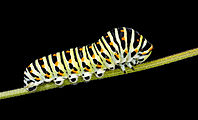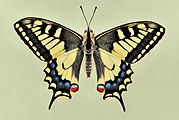- Papilio machaon
-
Old World Swallowtail 
Scientific classification Kingdom: Animalia Phylum: Arthropoda Class: Insecta Order: Lepidoptera Family: Papilionidae Genus: Papilio Species: P. machaon Binomial name Papilio machaon
Linnaeus, 1758The Old World Swallowtail (Papilio machaon) is a butterfly of the family Papilionidae. The butterfly is also known as the Common Yellow Swallowtail or simply the Swallowtail (a common name applied to all members of the family). It is the type species of the genus Papilio and occurs throughout the Palearctic region in Europe and Asia; it also occurs across North America, and thus, is not restricted to the Old World, despite the common name.
Contents
Description
Trailing edges of the hind wings resemble the tails of swallows
The imago typically has yellow wings with black vein markings, and a wingspan of 65–86 millimetres (2.6–3.4 in).[1] The hind wings of both sexes have a pair of protruding tails which give the butterfly its common name from the resemblance to the birds of the same name. Just below each tail is a red eye spot.
It can be distinguished from Papilio hospiton, which occurs sympatrically with it on Corsica and Sardinia, by the longer "tails" on the hind wings.[2] It can be told apart from the Algerian species Papilio saharae only by counting the segments on the antennae.[2]
Distribution and status
This butterfly is present throughout the entire Palearctic region, ranging from Russia to China and Japan, (including the Himalayas and Taiwan), and across into Alaska, Canada, and the United States.
In Asia it is reported as far south as Saudi Arabia, Oman, the high mountains of Yemen, Lebanon, and Israel. In Southern Asia it occurs in Pakistan and Kashmir, Northern India, (Sikkim, to Assam and Arunachal Pradesh) Nepal, Bhutan, and northern Myanmar.[3]
This butterfly is widespread in Europe. In the United Kingdom it is limited to a few areas in the Norfolk Broads of East Anglia.[4] It is the UK's largest resident butterfly. The Monarch Danaus plexippus is slightly larger, but is only a rare vagrant.
As P. machaon is widespread throughout Eurasia and often common, it is not threatened as a species.[3] It is listed as "Vulnerable" in the South Korean and Austrian Red Data Books, and in the Red Data Book of the former Soviet Union.[3]
In some countries, P. machaon or its subspecies are protected by law. Papilio machaon machaon is protected by law in six provinces of Austria, Czech Republic, Slovakia, Hungary, Romania, and Moldova. The species is protected in the United Kingdom, and subsp. verityi is protected in India.[3]
Movie of Papilio machaon caterpillar
Taxonomy
Papilio machaon was named by Carl Linnaeus in the 10th edition of Systema Naturae in 1758, alongside nearly 200 other species of butterfly. Later, Pierre André Latreille designated it as the type species of the genus Papilio.[5] The specific epithet machaon refers to Machaon, son of Asclepius in the works of Homer.[6]
There are 37 recognized subspecies.[3]
- Papilio machaon gorganus is strongly migratory in Europe and may be found in almost all habitats.
- In the UK, P. m. brittanicus is an endemic subspecies, but occasionally individuals of the continental subspecies gorganus breed temporarily on the south coast. Subspecies brittanicus differs from the continental subspecies in being more heavily marked in black.
- The Maltese Islands are home to another endemic subspecies, P. m. melitensis.
Ecology
The butterfly has a strong and fast flight, but frequently pauses to hover over flowering herbs and sip nectar. It frequents alpine meadows and hillsides, and males are fond of 'hilltopping', congregating near summits to compete for passing females.[2] At lower elevations it can be seen visiting gardens.
Unlike other swallowtails, this species specialises in using plants of family Umbelliferae, females laying eggs singly. Milk Parsley Peucedanum palustre (also known as Marsh Hog's Fennel) is normally the only food plant used by the caterpillars of the British subspecies.[2] The food plants of the Swallowtail in Europe, Asia, and North America are more varied than in the UK. It uses a wide variety of umbellifers including wild carrot Daucus carota, wild angelica Angelica sylvestris, fennel Foeniculum vulgare, and hogweeds Heracleum spp. In the Maltese Islands, the caterpillar feeds on plants such as rue Ruta chalepensis and fennel Foeniculum vulgare.
In Kashmir, the Common Yellow Swallowtail, as Papilio machaon is called there, inhabits alpine meadows in the Himalayas occurring from 2,000 feet (610 m) in Kashmir valley to 16,000 ft (4,900 m) in the Garhwal Himalayas. In India Himachal Pradesh, it is found over 4,000 ft (1,200 m) only and in Sikkim over 8,000 ft (2,400 m) only.
At lower elevations, these butterflies fly from March to September; at higher elevations, they are limited by the short summer seasons.
The British subspecies P. m. brittanicus is less mobile than its European continental counterpart and stays within, or close by, its fenland habitat.[2]
Life cycle
There usually are two to three broods in a year, but in northern areas the species may be univoltine. In some places such as the UK, some will pupate and emerge in the same year and others will overwinter as pupae before emerging the following year, a situation known as being partially bivoltine.
The caterpillar spends the first part of its life with the appearance of a bird dropping, an effective defense against predators.[2] As the caterpillar grows larger it becomes green with black and orange markings. It has a defense against predators in the form of an osmeterium, which consists of retractable, fleshy projections behind its head that can release a foul smell if disturbed, which deters insects, but not birds.[2]
Breeding
Old World Swallowtails can easily be bred in captivity.
Butterflies can be lured to lay eggs in a backyard garden by keeping plenty of caterpillar foodplants in it. Common Rue plants are highly appropriate for this.
Once eggs or young caterpillars have been collected, they can be kept in a pot with holes on its top to allow air circulation. More than one caterpillar may be kept in a single pot since they do not attack each other (although they might sometimes get frightened by other caterpillars moving). They can be fed any of their foodplants. Fennel is one of the easiest to find in the wild. Care must be taken with fennel, though, because they will not eat hard woody stems: they need to be fed the tender leaves. They can also be fed Rue or Milk Parsley. Feeding them with unsuitable plants will lead to death from starvation.
Caterpillars are very fast eaters; they will spend their time eating or resting before they resume their eating again.
Once a sufficient size has been attained, they will attach themselves to any available structure with their silky threads. They will then stay still until they become a pupa. This will take about a day. They will not build a woven chrysalid, they become internally a pupa and then they shed their skin.
Once in the pupa stage, they can be very carefully removed from the pot and placed in a warm location. The time the butterfly takes to form and come out depends on the temperature. If kept in warm summer temperatures it will take about one or two weeks to form. On the other hand, if the temperature is lower, it might take as long as several months until it feels the weather is warm enough.
Pupas should not be kept on an impermeable surface, since when they eclose a bit of liquid will be poured, this means they butterfly would get wet and might not be able to fly. Absorbing paper such as the one used in kitchens is advisable.
See also
References
- ^ Paul A. Opler & James Wilson Tilden (1999). "Old World Swallowtail Papilio machaon". A Field Guide to Western Butterflies. Volume 2 of Peterson field guide series (2nd ed.). Houghton Mifflin Harcourt. pp. 132–133. ISBN 9780395791516. http://books.google.co.uk/books?id=ilL_XX1rbNoC&pg=RA1-PA3.
- ^ a b c d e f g Adrian Hoskins. "Swallowtail. Papilio machaon Linnaeus, 1758". Butterflies of Europe. http://www.learnaboutbutterflies.com/Britain%20-%20Papilio%20machaon.htm. Retrieved September 24, 2010.
- ^ a b c d e N. Mark Collins & Michael G. Morris (1985). "Papilio (Papilio) machaon Linnaeus, 1758". Threatened swallowtail butterflies of the world: the IUCN red data book. IUCN Protected Area Programme Series. IUCN. pp. 93–94. ISBN 9782880326036. http://books.google.co.uk/books?id=RomV7uO_t9YC&pg=PA93.
- ^ "Swallowtail (Papilio machaon)". BBC. http://www.bbc.co.uk/nature/wildfacts/factfiles/410.shtml. Retrieved September 24, 2010.
- ^ E. D. Edwards, J. Newland & L. Regan (2001). "Papilionoidea: Papilionidae. Swallowtails". Lepidoptera: Hesperioidea, Papilionoidea. Volume 31 of Zoological Catalogue of Australia. CSIRO Publishing. pp. 409–443. ISBN 9780643067004. http://books.google.co.uk/books?id=iVHDuVVelGMC&pg=PA424.
- ^ Michael A. Salmon, Peter Marren & Basil Harley (2000). "The Swallowtail – Papilio machaon Linnaeus". The Aurelian legacy: British butterflies and their collectors. University of California Press. pp. 252–254. ISBN 9780520229631. http://books.google.co.uk/books?id=cAUTW-ax-SgC&pg=PA252.
Further reading
- Jim Asher et al. The Millennium Atlas of Butterflies of Britain and Ireland. Oxford:Oxford University Press.
External links
External identifiers for Papilio machaon EOL 130891 ITIS 777696 NCBI 76193 Also found in: Wikispecies  Data related to Papilio machaon at Wikispecies
Data related to Papilio machaon at Wikispecies- Lectotype of Papilio machaon on the website of the Linnean Society of London. Accessed 8 November 2010.
- Papilio machaon Linnaeus, 1758 European Butterflies and Moths
- Swallowtail, Papilio machaon, UK Butterflies
- http://en.wikipedia.org/wiki/Old_World_Swallowtail
Categories:- Papilio
- Butterflies and moths of Europe
- British butterflies
- Butterflies and moths of Asia
- Fauna of Pakistan
- Butterflies and moths of North America
- Animals described in 1758
Wikimedia Foundation. 2010.

